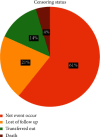Retinopathy among Adult Diabetics and Its Predictors in Northwest Ethiopia
- PMID: 35211627
- PMCID: PMC8863468
- DOI: 10.1155/2022/1362144
Retinopathy among Adult Diabetics and Its Predictors in Northwest Ethiopia
Abstract
Background: Diabetic retinopathy is the leading cause of blindness among working-aged adults worldwide, including developing countries such as Ethiopia, and the burden of diabetes-related blindness is undeniably posing a massive challenge to the health care system. Diabetes and its micro- and macrovascular complications are becoming more prevalent among Ethiopian diabetics. For that reason, the purpose of this study was to assess the incidence of diabetic retinopathy and its predictors among diabetics in Ethiopia.
Methods: A hospital-based retrospective cohort study was conducted using 494 randomly selected diabetics aged above 18 years at Felege Hiwot Comprehensive Specialized Hospital from 2011 through 2014 and was followed until December 2019. The preliminary and longitudinal data was abstracted into demographics, clinical, and physiological attributes using a standardized structured questionnaire. The collected data was entered into the system using EpiData version 4.2 and analyzed using STATA version 14.0. The survival experience of the patients was assessed using the Kaplan-Meier survivor function. The predictors of diabetic retinopathy were identified by the Cox proportional hazard model. Bivariable and multivariable Cox proportional hazard models were computed, and variables having a P value of < 0.05 in the multivariable Cox proportional hazard model were declared as significant predictors of diabetic retinopathy.
Results: During the follow-up, the overall incidence rate of diabetic retinopathy was 48 per 1000 person-years (95% CI: 40.0-57.0). Age in years (AHR 1.02; 95% CI: 1.00-1.04), fasting blood sugar level (AHR 1.02; 1.00-1.04), hypertension (AHR 2.61; 95% CI: 1.47-4.63), DM patients who had LDL > 100 mg/dl (AHR 2.73; 95% CI: 1.32-5.64), total cholesterol > 200 mg/dl (AHR 2.22; 95% CI: 1.08-4.55), and positive proteinuria (AHR 1.74; 95% CI: 1.10 -2.73) were found to be the significant predictors of diabetic retinopathy.
Conclusion: The overall incidence rate of diabetic retinopathy was found to be high in both type 1 and type 2 DM. Age, fasting blood sugar levels, hypertension, proteinuria, dyslipidemia, and high systolic blood pressure were all predictors of the development of diabetic retinopathy. Controlling glycemia, dyslipidemia, proteinuria, and blood pressure is critical for halting the progression of diabetic retinopathy.
Copyright © 2022 Mulualem Birhan Takele et al.
Conflict of interest statement
The authors have declared that no conflicting interests exist.
Figures



Similar articles
-
Time to diabetic neuropathy and its predictors among adult type 2 diabetes mellitus patients in Amhara regional state Comprehensive Specialized Hospitals, Northwest Ethiopia, 2022: A retrospective follow up study.PLoS One. 2023 Apr 28;18(4):e0284568. doi: 10.1371/journal.pone.0284568. eCollection 2023. PLoS One. 2023. PMID: 37115732 Free PMC article.
-
Diabetic retinopathy incidence, predictors and its association with longitudinal fasting blood sugar level changes among diabetes mellitus patients in Ethiopia: joint model.Front Endocrinol (Lausanne). 2024 Jul 8;15:1363757. doi: 10.3389/fendo.2024.1363757. eCollection 2024. Front Endocrinol (Lausanne). 2024. PMID: 39040673 Free PMC article.
-
Incidence of diabetic retinopathy and its predictors among adult patients with diabetes in Ethiopia: a frailty model.Front Endocrinol (Lausanne). 2025 Mar 14;16:1462210. doi: 10.3389/fendo.2025.1462210. eCollection 2025. Front Endocrinol (Lausanne). 2025. PMID: 40162316 Free PMC article.
-
The incidence and predictors of peripheral arterial disease among type 2 diabetes mellitus patients at Felege Hiwot Comprehensive Specialized Hospital, Northwest Ethiopia, 2023: A retrospective follow-up study.PLoS One. 2025 Apr 1;20(4):e0320948. doi: 10.1371/journal.pone.0320948. eCollection 2025. PLoS One. 2025. PMID: 40168272 Free PMC article.
-
Prevalence of diabetic retinopathy and its associated risk factors among adults in Ethiopia: a systematic review and meta-analysis.Sci Rep. 2024 Nov 16;14(1):28266. doi: 10.1038/s41598-024-78596-9. Sci Rep. 2024. PMID: 39550444 Free PMC article.
Cited by
-
Determinants of diabetic retinopathy in Ethiopia: A systematic review and meta-analysis.PLoS One. 2023 Jun 8;18(6):e0286627. doi: 10.1371/journal.pone.0286627. eCollection 2023. PLoS One. 2023. PMID: 37289766 Free PMC article.
-
Incidence of diabetic retinopathy and predictors among adult patients with diabetes in central and southern Ethiopia: a multicentre retrospective cohort study.BMJ Open. 2025 Jan 21;15(1):e090916. doi: 10.1136/bmjopen-2024-090916. BMJ Open. 2025. PMID: 39842931 Free PMC article.
-
Incidence and progression of diabetic retinopathy and blindness in Indonesian adults with type 2 diabetes.PLoS One. 2025 Aug 29;20(8):e0322093. doi: 10.1371/journal.pone.0322093. eCollection 2025. PLoS One. 2025. PMID: 40880415 Free PMC article.
-
Visual impairment among diabetes patients in Ethiopia: A systematic review and meta-analysis.PLoS One. 2024 May 31;19(5):e0303388. doi: 10.1371/journal.pone.0303388. eCollection 2024. PLoS One. 2024. PMID: 38820429 Free PMC article.
-
Prevalence of diabetic retinopathy and its associated factors among adults in East African countries: A systematic review and meta-analysis.PLoS One. 2025 Jan 31;20(1):e0316160. doi: 10.1371/journal.pone.0316160. eCollection 2025. PLoS One. 2025. PMID: 39888910 Free PMC article.
References
-
- Brunner L. S. Brunner & Suddarth’s Textbook of Medical-Surgical Nursing . Lippincott Williams & Wilkins; 2010.
-
- Roglic G. WHO global report on diabetes: a summary. Int J Non-Commun Dis. . 2016;1
-
- Chow S.-C., Shao J., Wang H., Lokhnygina Y. Sample size calculations in clinical research . Chapman and Hall/CRC; 2017.
MeSH terms
LinkOut - more resources
Full Text Sources
Medical

